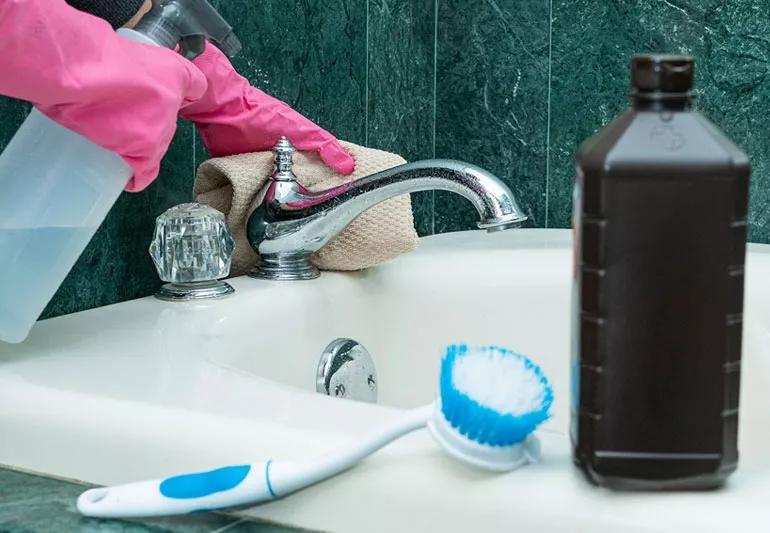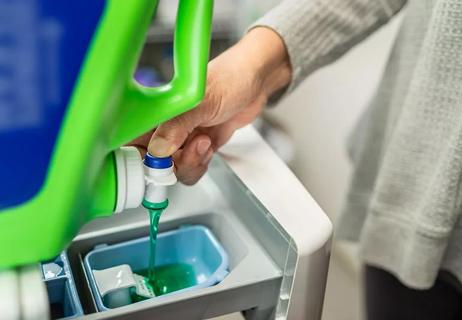It’s a disinfectant, cleaner and stain fighter — here’s how to use it safely

Who can forget the stinging sensation that occurs when your parents put hydrogen peroxide on a scraped knee?
Advertisement
Cleveland Clinic is a non-profit academic medical center. Advertising on our site helps support our mission. We do not endorse non-Cleveland Clinic products or services. Policy
Found in a brown bottle, hydrogen peroxide is an antiseptic liquid that in the past was typically used to treat cuts or other skin wounds, and kill germs. However, peroxide is often used in non-medical situations, including for cleaning, disinfecting and stain removal.
In fact, hydrogen peroxide has plenty of uses, some of them surprising. Family medicine physician Sarah Pickering Beers, MD, explains why hydrogen peroxide is helpful to have around.
Hydrogen peroxide is water (H2O) with an extra oxygen molecule (H2O2).
“The extra oxygen molecule oxidizes, which is how peroxide gets its power,” says Dr. Beers. “This oxidation kills germs and bleaches color from porous surfaces like fabrics.”
When you use peroxide, go for medical-grade peroxide, which is 3% strength. That means it’s 97% water and 3% peroxide. “Medical grade is strong enough for household use,” says Dr. Beers.
You can also buy a more concentrated form of hydrogen peroxide, called food-grade peroxide, with strength as high as 35%. It’s called “food-grade” because the food industry uses it for several purposes, such as processing and bleaching certain foods.
However, Dr. Beers says to skip it.
“Food-grade peroxide can be toxic if you inhale it or get it on your skin. And that high strength isn’t necessary for cleaning and disinfecting.”
Advertisement
Hydrogen peroxide can be used everywhere from your kitchen to your bathroom. But keep it away from wounds and acne.
It’s time to retire peroxide from first-aid duty. Let’s all breathe a collective sigh of relief.
“Hydrogen peroxide has fallen out of favor as a wound cleanser,” Dr. Beers says. “Studies have found that it irritates the skin. It may prevent the wound from healing, doing more harm than good.”
So what do you use on a scrape or cut? “A good wash with soap and plenty of clean water is all you need,” Dr. Beers says. After washing, pat dry with a clean towel. Then apply an antibiotic ointment and cover it with a bandage.
Seek medical care for larger wounds and gashes, excessive bleeding or if there’s debris stuck in the wound.
Peroxide kills germs, and you may have acne treatments that contain benzoyl peroxide. But hydrogen peroxide and benzoyl peroxide are not the same. Don’t use hydrogen peroxide for acne.
As Dr. Beers explains, “Hydrogen peroxide can be irritating, which can make acne worse. And it dissolves in water. So the germ-killing effects don’t last long on the skin.” Benzoyl peroxide forms a film on the skin so it can penetrate the pore and continue to fight acne bacteria for several hours.
Use products with benzoyl peroxide or salicylic acid for acne breakouts. If breakouts still won’t take a hike, see your doctor.
Get ready for the wonderful world of H202—you can use hydrogen peroxide to:
Move your peroxide from the medicine cabinet to the cleaning cabinet. It’s a great alternative to bleach and won’t make your house smell like a swimming pool.
Use peroxide in a well-ventilated area and wear gloves. “There’s a chance of toxicity if you inhale it, and it can irritate the skin and eyes,” Dr. Beers says.
To disinfect, first clean any visible dirt or grime off the area with plain soap and water. Then spray surfaces with a 50/50 mix of peroxide and water. Let it sit for five minutes or longer. Rinse surfaces that touch food, like cutting boards, but let other surfaces air dry.
Hydrogen peroxide is a great germ-killer for:
“Peroxide kills bacteria, fungi and viruses,” Dr. Beers explains. “It can come in handy if you don’t have disinfecting wipes or bleach. Just be careful not to get it on your clothes or furniture, or it may bleach them.”
Looking for a cheap and effective way to remove germs and pesticides from fruits and vegetables? Peroxide can do the job.
Advertisement
Fill a large bowl or clean sink with water and add one-fourth cup of peroxide. Wash produce in the water and peroxide mixture, rinse thoroughly with clean water and dry. Bonus: Cleaning your produce with peroxide could extend its shelf life.
Don’t try this cleaning method with household disinfecting sprays or wipes. They contain chemicals that aren’t safe to use on food.
Peroxide has serious bleaching power, making it an effective stain remover. But don’t use it on colored items. And always test it in a hidden area first.
Here are a few ways peroxide gets rid of annoying spots and stains:
Advertisement
Peroxide isn’t a skin care product, but it is found in certain common items, such as whitening toothpaste or mouthwash. “Peroxide is also an ingredient in many tooth whiteners,” says Dr. Beers. However, talk to your dentist before using whitening products, since they can cause tooth sensitivity.
You can also use it to:
Hydrogen peroxide is a chemical. It can cause serious side effects if it’s ingested. Keep it in a locked cabinet out of reach of children and pets.
Advertisement
Before using peroxide, check the expiration date. “The extra oxygen breaks down over time,” Dr. Beers says. “Once it loses its bubbles, you’re basically left with water.” Keep peroxide in its original brown bottle or a dark spray bottle to avoid exposing it to light. If it’s not foaming anymore, dump it down the sink and buy a new bottle.
And rest easy knowing you’ll never again have to endure its sting on boo-boos.
Learn more about our editorial process.
Advertisement

PFAS chemicals that make life easier aren’t always so easy on the human body

Researchers have identified nearly 800 chemicals of concern

Most recommended precautions center around minimizing bruising or swelling

Even one drink can have an impact on your cognitive function leading to slurred speech, blurred vision and impaired memory

Understand who may (and may not) benefit

Lorem ipsum dolor sit amet. Et odio Quis vel ipsam omnis eum alias deleniti et placeat impedit non voluptas galisum hic autem enim et cupiditate aliquid. Est beatae quidem non facilis autem ut commodi nisi aut tempore rerum et dolores voluptatem cum enim optio id sapiente quasi. Ad laboriosam officiis 33 cupiditate sequi ea voluptatum consectetur qui necessitatibus voluptate et quasi doloremque et facere explicabo quo explicabo officia

Type 2 diabetes isn’t inevitable with these dietary changes

Applying a hot or cold compress can help with pain